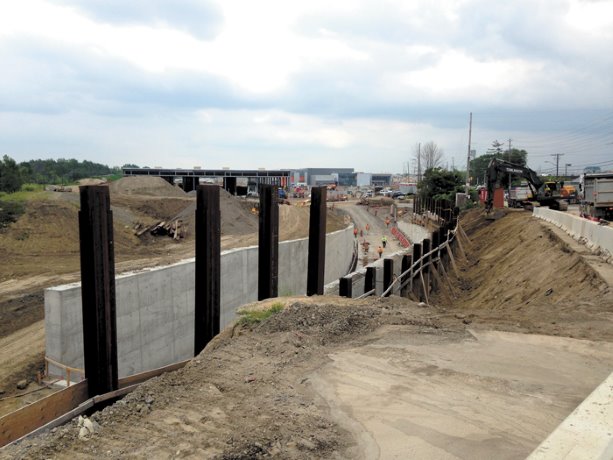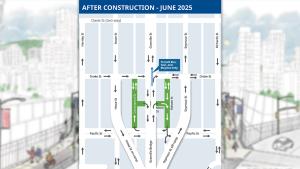Downtown tunnelling is done, work is proceeding speedily on 13 new stations and the 2018 finish line for phase one of Ottawa’s transformative $5-billion-plus Confederation Line LRT build is squarely in sight.
But it’s not these milestones nor the hum of testing of locally assembled electric rail cars near the busy Belfast Yard facility that are earning the admiration of the international infrastructure community, says Chris Swail, director of O-Train planning.
Rather, it’s procurement. The Ottawa LRT project is the first build of its type to use Ontario’s alternative financing and procurement (AFP) model, and that’s causing a tide of interest internationally and prompting visits from infrastructure investors from such diverse destinations as Australia and Jerusalem, Swail said.
And as the $3-billion phase two procurement process gets underway this year, it’s more of the same, with unique contractual arrangements being devised and implemented, he explained.
"I think ultimately what the Ottawa project was known for and will continue to be known for, it was the first time AFP was used to deliver linear transit infrastructure," said Swail, when asked to name the top innovation associated with the project.
"In terms of efficiencies and approach, there is a lot of innovation built in having the same group design and then implement their plans through that AFP model. That is hugely beneficial when it comes to linear transit infrastructure. The idea that you are not specifying what needs to be built, you are specifying how that asset needs to perform, that…whole model has been hugely beneficial to the city."
Construction began on phase one — a $2.13-billion, 12.5-kilometre electrified LRT line with a 2.5-kilometre tunnel beneath the downtown core, along with other associated projects — in 2013, after the consortium Rideau Transit Group (RTG) was selected among qualified proponents. Members of RTG include SNC-Lavalin, EllisDon and Dragados Canada, with Alstom, Hatch Mott MacDonald, MMM Group and Fast + Epp among others also participating.
Funding came from the federal, provincial and city governments.
The first major step was widening Highway 417 to permit operation of Bus Rapid Transit during construction. Fabrication of the Alstrom-built rail vehicles in the Belfast Yard began in 2015. The eastern and western sections of the tunnel were joined last December after four years of tunnelling.
This year is scheduled to be the busiest yet, with construction underway at all stations as well as along the guideway where tracks are being laid. Meanwhile, the Overhead Catenary System, supplying power to the trains, continues to be energized.
The build has not been without its problems, some highly publicized.
Two sinkholes developed during downtown excavations, the larger of which, on Rideau Street in 2016, was called a "significant setback" by Swail.
"They have had to apply significant resources to get caught up and they’ll continue to do so in order to meet revenue service in late May (2018)," he said.
"But that is the beauty of the model. We are successfully transferring the risk from the tunnel, we had many doubters originally in terms of what we were trying to achieve in terms of the procurement, we did a lot a lot of additional geotech work in the planning stages in order to achieve that risk transfer, and we did, and the proof is in the concept."
The first week of August, Ontario’s Ministry of Labour laid eight charges against the consortium and individual companies for alleged violations of the Occupational Health and Safety Act.
The charges as described were mainly for unkempt workplaces. A consortium spokesperson said there would be no comment as the matter is before the courts.
Tripartite funding for phase two, amounting to over $3 billion, was confirmed in June after Ottawa council gave its go-ahead in March. The Confederation Line east and west will be extended 12 and 11 kilometres respectively with electrified LRT while a 15-kilometre Trillium Line will be built southbound, with trains to run on diesel. The builds will be staggered with ultimate completion expected by 2023.
As Swail explains it, procurement for phase two continues to manifest innovation and ingenuity. The city needs competitive pricing, Swail said, but it made no sense for some elements of the proposed contracts to go out to bid.
"If you are trying to go out to market with this, you are faced with a number of challenges," he said. "One is, RTG right now has already built a substantial maintenance and storage facility. Anyone else who would compete with the bid would have to build their own at roughly a $200-million deficit in trying to compete against RTG."
Similarly, it would be problematic from an "interface perspective" if another contractor started building its own track and running its own vehicles on it and existing RTG track, and vice versa, Swail said.
The solution was a memorandum of understanding reached earlier this year and confirmed June 27 that will see certain elements of phase two work assigned to RTG but the bulk, around $2.5 billion worth, Swail said, for civil work and other projects, will be bid upon. A design, build, finance procurement process is currently underway for the Confederation Line extensions.
"What we did was fairly unique from a procurement perspective in a unique circumstance," said Swail.

1/2
Photo:











Recent Comments
comments for this post are closed